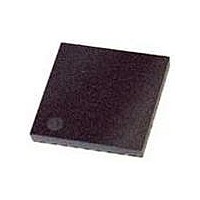ATTINY861-15MZ Atmel, ATTINY861-15MZ Datasheet - Page 159

ATTINY861-15MZ
Manufacturer Part Number
ATTINY861-15MZ
Description
MCU AVR 8K FLASH 15MHZ 32-QFN
Manufacturer
Atmel
Series
AVR® ATtinyr
Datasheet
1.ATTINY861-15MZ.pdf
(236 pages)
Specifications of ATTINY861-15MZ
Package / Case
32-VQFN Exposed Pad, 32-HVQFN, 32-SQFN, 32-DHVQFN
Voltage - Supply (vcc/vdd)
2.7 V ~ 5.5 V
Operating Temperature
-40°C ~ 125°C
Speed
16MHz
Number Of I /o
16
Eeprom Size
512 x 8
Core Processor
AVR
Program Memory Type
FLASH
Ram Size
512 x 8
Program Memory Size
8KB (8K x 8)
Data Converters
A/D 11x10b
Oscillator Type
Internal
Peripherals
Brown-out Detect/Reset, POR, PWM, WDT
Connectivity
USI
Core Size
8-Bit
Processor Series
ATTINY8x
Core
AVR8
Data Bus Width
8 bit
Data Ram Size
512 B
Interface Type
SPI
Maximum Clock Frequency
16 MHz
Number Of Programmable I/os
16
Number Of Timers
2
Maximum Operating Temperature
+ 85 C
Mounting Style
SMD/SMT
3rd Party Development Tools
EWAVR, EWAVR-BL
Development Tools By Supplier
ATAVRDRAGON, ATSTK500, ATSTK600, ATAVRISP2, ATAVRONEKIT, ATAVRMC320
Minimum Operating Temperature
- 40 C
On-chip Adc
10 bit, 11 Channel
Lead Free Status / RoHS Status
Lead free / RoHS Compliant
Available stocks
Company
Part Number
Manufacturer
Quantity
Price
Company:
Part Number:
ATTINY861-15MZ
Manufacturer:
ATMEL
Quantity:
1 465
- Current page: 159 of 236
- Download datasheet (2Mb)
2588B–AVR–11/06
• Bits 7– BIN: Bipolar Input Mode
The gain stage is working in the unipolar mode as default, but the bipolar mode can be selected
by writing the BIN bit in the ADCSRB register. In the unipolar mode only one-sided conversions
are supported and the voltage on the positive input must always be larger than the voltage on
the negative input. Otherwise the result is saturated to the voltage reference. In the bipolar mode
two-sided conversions are supported and the result is represented in the two’s complement
form. In the unipolar mode the resolution is 10 bits and the bipolar mode the resolution is 9 bits +
1 sign bit.
• Bits 6 – GSEL: Gain Select
The Gain Select bit selects the 32x gain instead of the 20x gain and the 8x gain instead of the 1x
gain when the Gain Select bit is written to one.
• Bits 5 – Res: Reserved Bit
This bit is a reserv ed bit in the ATtiny261/461/861 and will always read as zero.
• Bits 4 – REFS2: Reference Selection Bit
These bit selects either the voltage reference of 1.1 V or 2.56 V for the ADC, as shown in
19-3. If active channels are used, using AVCC or an external AREF higher than (AVCC - 1V) is
not recommended, as this will affect ADC accuracy. The internal voltage reference options may
not be used if an external voltage is being applied to the AREF pin.
• Bits 3 – MUX5: Analog Channel and Gain Selection Bit 5
The MUX5 bit is the MSB of the Analog Channel and Gain Selection bits. Refer to
details. If this bit is changed during a conversion, the change will not go into effect until this
conversion is complete (ADIF in ADCSRA is set).
• Bits 2:0 – ADTS2:0: ADC Auto Trigger Source
If ADATE in ADCSRA is written to one, the value of these bits selects which source will trigger
an ADC conversion. If ADATE is cleared, the ADTS2:0 settings will have no effect. A conversion
will be triggered by the rising edge of the selected Interrupt Flag. Note that switching from a trig-
ger source that is cleared to a trigger source that is set, will generate a positive edge on the
trigger signal. If ADEN in ADCSRA is set, this will start a conversion. Switching to Free Running
mode (ADTS[2:0]=0) will not cause a trigger event, even if the ADC Interrupt Flag is set
Table 19-6.
ADTS2
0
0
0
0
1
1
1
1
ADC Auto Trigger Source Selections
ADTS1
0
0
1
1
0
0
1
1
ADTS0
0
1
0
1
0
1
0
1
Trigger Source
Free Running mode
Analog Comparator
External Interrupt Request 0
Timer/Counter0 Compare Match A
Timer/Counter0 Overflow
Timer/Counter0 Compare Match B
Timer/Counter1 Overflow
Watchdog Interrupt Request
ATtiny261/461/861
Table 19-4
.
Table
159
for
Related parts for ATTINY861-15MZ
Image
Part Number
Description
Manufacturer
Datasheet
Request
R

Part Number:
Description:
Manufacturer:
Atmel Corporation
Datasheet:

Part Number:
Description:
Manufacturer:
Atmel Corporation
Datasheet:

Part Number:
Description:
IC MCU AVR 8K FLASH 20MHZ 32-QFN
Manufacturer:
Atmel
Datasheet:

Part Number:
Description:
IC MCU AVR 8K FLASH 20MHZ 20SOIC
Manufacturer:
Atmel
Datasheet:

Part Number:
Description:
MCU AVR 8K FLASH 15MHZ 20-SOIC
Manufacturer:
Atmel
Datasheet:

Part Number:
Description:
MCU AVR 8KB FLASH 15MHZ 32-VQFN
Manufacturer:
Atmel
Datasheet:

Part Number:
Description:
Microcontrollers (MCU) 8kB Flash 0.512kB EEPROM 16 I/O Pins
Manufacturer:
Atmel
Datasheet:

Part Number:
Description:
8-bit Microcontrollers - MCU 8KB FL 512B EE 512B SRAM 20MHZ IND 5V
Manufacturer:
Atmel

Part Number:
Description:
IC, MCU, 8BIT, 2K FLASH, 20SOIC
Manufacturer:
Atmel
Datasheet:

Part Number:
Description:
IC, MCU, 8BIT, 2K FLASH, 20PDIP
Manufacturer:
Atmel
Datasheet:













